Scientometric Analysis of Safety Sign Research: 1990–2019
Abstract
1. Introduction
2. Materials and Methods
2.1. Research Tool
2.2. Data Sources
3. Results
3.1. General Feature of Published Research
3.2. Author’s Analysis
3.3. Journal Source and Category Analysis
3.4. The Research Theme of Safety Signs
3.5. The Hotspots of Safety Signs Research
4. Discussion
4.1. Main Findings
4.2. Theoretical and Practical Implications
4.3. Limitations and Future Research Directions
5. Conclusions
Author Contributions
Funding
Institutional Review Board Statement
Informed Consent Statement
Data Availability Statement
Conflicts of Interest
References
- Duarte, E.; Rebelo, F.; Teles, J.; Wogalter, M.S. Safety sign comprehension by students, adult workers and disabled persons with cerebral palsy. Saf. Sci. 2014, 62, 175–186. [Google Scholar] [CrossRef]
- ISO. Graphical symbols. Safety colours and safety signs. In Part 3: Design Principles for Graphical Symbols for Use in Safety Signs; BS ISO 3864-3; International Standards Organisation (ISO): Geneva, Switzerland, 2012. [Google Scholar]
- Laughery, K.R. Safety communications: Warnings. Appl. Ergon. 2006, 37, 467–478. [Google Scholar] [CrossRef] [PubMed]
- Wogalter, M.S.; Godfrey, S.S.; Fontenelle, G.A.; Desaulniers, D.R.; Rothstein, P.R.; Laughery, K.R. Effectiveness of Warnings. Hum. Factors J. Hum. Factors Ergon. Soc. 1987, 29, 599–612. [Google Scholar] [CrossRef]
- Braun, C.C.; Silver, N.C. Interaction of signal word and colour on warning labels: Differences in perceived hazard and behavioural compliance. Ergonomics 1995, 38, 2207–2220. [Google Scholar] [CrossRef] [PubMed]
- Wogalter, M.S.; Laughery, K.R. Warning! Sign and Label Effectiveness. Curr. Dir. Psychol. Sci. 1996, 5, 33–37. [Google Scholar] [CrossRef]
- Henderson, J.M.; Williams, C.C.; Castelhano, M.S.; Falk, R.J. Eye movements and picture processing during recognition. Percept. Psychophys. 2003, 65, 725–734. [Google Scholar] [CrossRef] [PubMed]
- Wang, Y.; Wang, K.; Ma, Q. Research on Chinese perceptions of implied hazard for warning signal words and surrounding shapes based on computer experiments. In Proceedings of the Portland International Conference on Management of Engineering & Technology, Cape Town, South Africa, 27–31 July 2008. [Google Scholar]
- Chan, A.H.S.; Ng, A.W.Y. Investigation of guessability of industrial safety signs: Effects of prospective-user factors and cognitive sign features. Int. J. Ind. Ergon. 2010, 40, 689–697. [Google Scholar] [CrossRef]
- Chen, J.; Wang, R.Q.; Lin, Z.; Guo, X. Measuring the cognitive loads of construction safety sign designs during selective and sustained attention. Saf. Sci. 2018, 105, 9–21. [Google Scholar] [CrossRef]
- Laughery, K.R.; Wogalter, M.S. A three-stage model summarizes product warning and environmental sign research. Saf. Sci. 2014, 61, 3–10. [Google Scholar] [CrossRef]
- Miller, J.M.; Lehto, M.R. Warnings. In Fundamentals, Design and Evaluation Methodologies; Fuller Technical Publications: Ann Arbor, MI, USA, 1987; Volume 1. [Google Scholar]
- Garfield, E. From the science of science to Scientometrics visualizing the history of science with HistCite software. J. Informetr. 2009, 3, 173–179. [Google Scholar] [CrossRef]
- Hosseini, M.R.; Martek, I.; Zavadskas, E.K.; Aibinu, A.A.; Arashpour, M.; Chileshe, N. Critical evaluation of off-site construction research: A Scientometric analysis. Autom. Constr. 2018, 87, 235–247. [Google Scholar] [CrossRef]
- Jin, R.; Zou, P.X.W.; Piroozfar, P.; Wood, H.; Yang, Y.; Yan, L.; Han, Y. A Science Mapping Approach Based Review of Construction Safety Research. Saf. Sci. 2019, 113, 285–297. [Google Scholar] [CrossRef]
- Li, J.; Yang, M.; Wu, C. Analysis of topics structure and frontier of safety science. China Saf. Sci. J. 2017, 27, 7–12. [Google Scholar] [CrossRef]
- Chen, Y.; Chen, C.; Hu, Z.; Wang, X. Principles and Applications of Analyzing a Citation Space; Science Press: Beijing, China, 2014; p. 164. [Google Scholar]
- Li, J.; Chen, C. CiteSpace: Text Mining and Visualization in Scientific Literature, 2nd ed.; Capital University of Economics and Business Press: Beijing, China, 2017; p. 301. [Google Scholar]
- Martín-Martín, A.; Orduna-Malea, E.; Thelwall, M.; DelgadoLópez-Cózar, E. Google Scholar, Web of Science, and Scopus: A systematic comparison of citations in 252 subject categories. J. Informetr. 2018, 12, 1160–1177. [Google Scholar] [CrossRef]
- Falagas, M.; Pitsouni, E.; Malietzis, G.; Pappas, G. Comparison of PubMed, Scopus, Web of Science, and Google Scholar: Strengths and weaknesses. FASEB J. Off. Publ. Fed. Am. Soc. Exp. Biol. 2008, 22, 338–342. [Google Scholar] [CrossRef] [PubMed]
- Chen, C.; Hu, Z.; Liu, S.; Tseng, H. Emerging trends in regenerative medicine: A scientometric analysis in CiteSpace. Expert Opin. Biol. Ther. 2012, 12, 593–608. [Google Scholar] [CrossRef] [PubMed]
- Yang, J.; Yan, X.; Xue, Q.; Li, X.; Duan, K.; Hang, J.; Li, W. Exploring the Effects of Signs’ Design and In-Vehicle Audio Warning on Driver Behavior at Flashing-Light-Controlled Grade Crossings: A Driving Simulator-Based Study. J. Adv. Transp. 2019, 2019, 1–21. [Google Scholar] [CrossRef]
- Wu, Y.; Zhang, Y.; Zhou, C.; Wang, J.; Ren, T. Study of CO Sources and Early-warning Concentration of Spontaneous Combustion at Air Return Corner in Fully Mechanized Mining Faces. Combust. Ence Technol. 2019, 1–18. [Google Scholar] [CrossRef]
- Redfern, O.C.; Smith, G.B.; Prytherch, D.R.; Paul, M.; Matthew, I.K.; Schmidt, P.E. A Comparison of the Quick Sequential (Sepsis-Related) Organ Failure Assessment Score and the National Early Warning Score in Non-ICU Patients With/Without Infection. Crit. Care Med. 2018, 46, 1923–1933. [Google Scholar] [CrossRef]
- Wang, J.; Wu, J.; Zheng, X.; Ni, D.; Li, K. Driving safety field theory modeling and its application in pre-collision warning system. Transp. Res. Part C Emerg. Technol. 2016, 72, 306–324. [Google Scholar] [CrossRef]
- Lee, J.D.; Gore, B.F.; Campbell, J.L. Display Alternatives for In-Vehicle Warning and Sign Information: Message Style, Location, and Modality. Transp. Hum. Factors 1999, 1, 347–375. [Google Scholar] [CrossRef]
- Kakkasageri, M.S.; Manvi, S.S. Information management in vehicular ad hoc networks: A review. J. Netw. Comput. Appl. 2014, 39, 334–350. [Google Scholar] [CrossRef]
- Tak, S.; Kim, S.; Yeo, H. Development of a Deceleration-Based Surrogate Safety Measure for Rear-End Collision Risk. IEEE Trans. Intell. Transp. Syst. 2015, 16, 2435–2445. [Google Scholar] [CrossRef]
- Biswas, S.; Tatchikou, R.; Dion, F. Vehicle-to-vehicle wireless communication protocols for enhancing highway traffic safety. IEEE Commun. Mag. 2006, 44, 74–82. [Google Scholar] [CrossRef]
- Winkler, S.; Kazazi, J.; Vollrath, M. How to warn drivers in various safety-critical situations—Different strategies, different reactions. Accid. Anal. Prev. 2018, 117, 410–426. [Google Scholar] [CrossRef] [PubMed]
- Winkler, S.; Kazazi, J.; Vollrath, M. Practice makes better—Learning effects of driving with a multi-stage collision warning. Accid. Anal. Prev. 2018, 117, 398–409. [Google Scholar] [CrossRef] [PubMed]
- Jermakian, J.S. Crash avoidance potential of four passenger vehicle technologies. Accid Anal. Prev. 2011, 43, 732–740. [Google Scholar] [CrossRef]
- Edworthy, J.; Loxley, S.; Dennis, I. Improving auditory warning design: Relationship between warning sound parameters and perceived urgency. Hum. Factors 1991, 33, 205. [Google Scholar] [CrossRef]
- Meredith, C.; Edworthy, J. Are there too many alarms in the intensive care unit? An overview of the problems. J. Adv. Nurs. 2010, 21, 15–20. [Google Scholar] [CrossRef]
- Kleinberg, J. Bursty and hierarchical sturcture in steams. Data Min. Knowl. Discov. 2003, 7, 373–397. [Google Scholar] [CrossRef]
- Smalley, W.; Shatin, D.; Wysowski, D.K.; Gurwitz, J.; Andrade, S.E.; Goodman, M.; Chan, K.A.; Platt, R.; Schech, S.D.; Ray, W.A. Contraindicated Use of Cisapride. JAMA J. Am. Med Assoc. 2000, 284, 3036. [Google Scholar] [CrossRef] [PubMed]
- Lasser Karen, E.; Allen Paul, D.; Woolhandler Steffie, J.; Himmelstein David, U.; Wolfe Sidney, M. Timing of New Black Box Warnings and Withdrawals for Prescription Medications. JAMA J. Am. Med. Assoc. 2002, 287, 2215–2220. [Google Scholar] [CrossRef] [PubMed]
- Kurian, B.T.; Ray, W.A.; Arbogast, P.G.; Fuchs, D.C.; Dudley, J.A.; Cooper, W.O. Effect of Regulatory Warnings on Antidepressant Prescribing for Children and Adolescents. Arch. Pediatr. Adolesc. Med. 2007, 161, 690–696. [Google Scholar] [CrossRef] [PubMed][Green Version]
- Sorensen, J.H. Hazard Warning Systems: Review of 20 Years of Progress. Nat. Hazards Rev. 2000, 1, 119–125. [Google Scholar] [CrossRef]
- Swuste, P.; Groeneweg, J.; van Gulijk, C.; Zwaard, W.; Lemkowitz, S.; Oostendorp, Y. The future of safety science. Saf. Sci. 2020, 125, 1–9. [Google Scholar] [CrossRef]
- Chapains, A. Hazards associated with three signal words and four colours on warning signs. Ergonomics 1994, 37, 265–275. [Google Scholar] [CrossRef]
- Adams, A.; Bochner, S.; Bilik, L. The effectiveness of warning signs in hazardous work places: Cognitive and social determinants. Appl. Ergon. 1998, 29, 247–254. [Google Scholar] [CrossRef]
- Zaklouta, F.; Stanciulescu, B. Real-time traffic sign recognition in three stages. Robot. Auton. Syst. 2014, 62, 16–24. [Google Scholar] [CrossRef]
- Sun, L.; Yao, L.; Rong, J.; Lu, J.; Liu, B.; Wang, S. Simulation Analysis on Driving Behavior during Traffic Sign Recognition. Int. J. Comput. Intell. Syst. 2011, 4, 353–360. [Google Scholar] [CrossRef]
- Siswandari, Y.; Xiong, S. Eye movements and brain oscillations to symbolic safety signs with different comprehensibility. J. Physiol. Anthropol. 2018, 37, 30. [Google Scholar] [CrossRef]
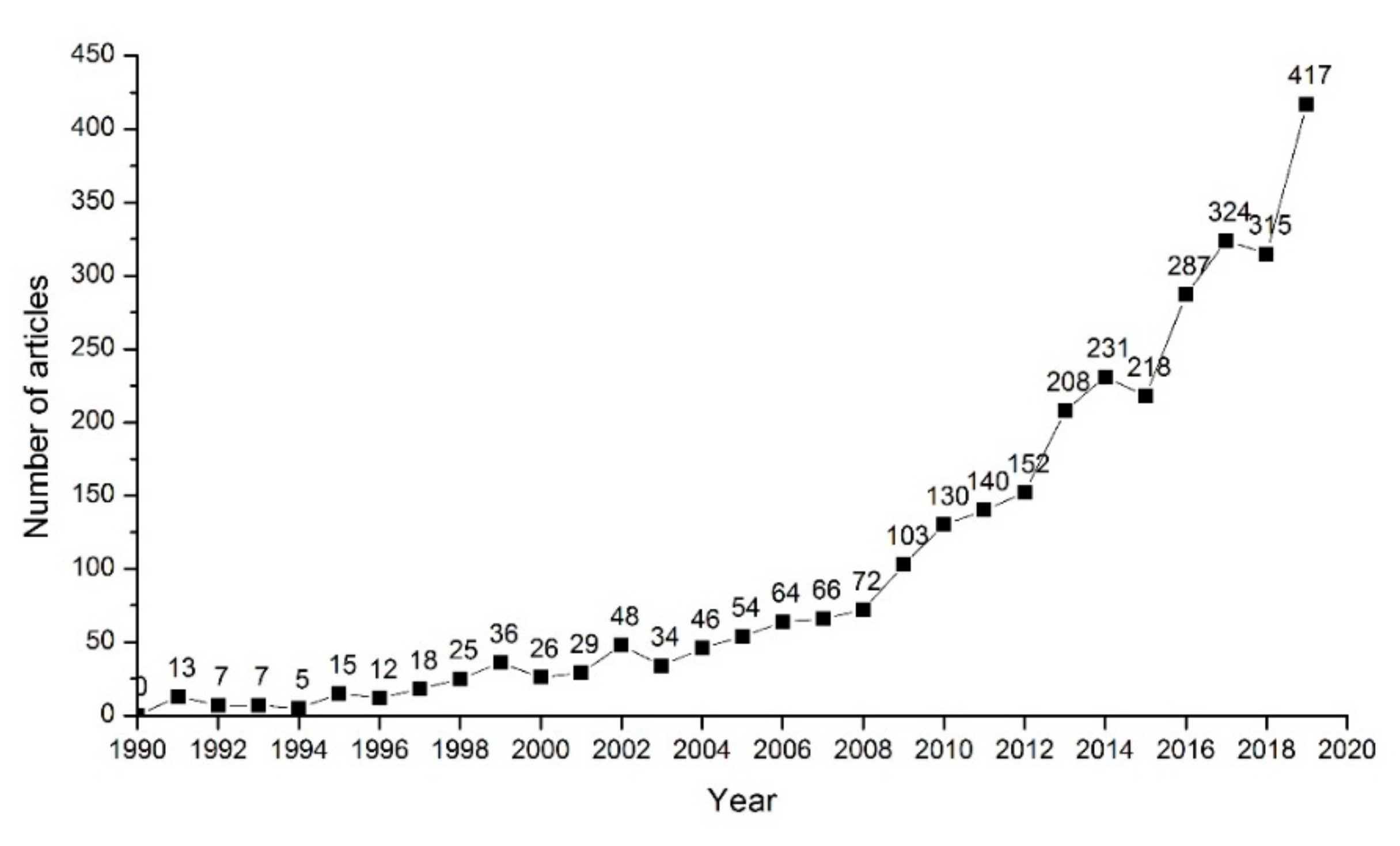
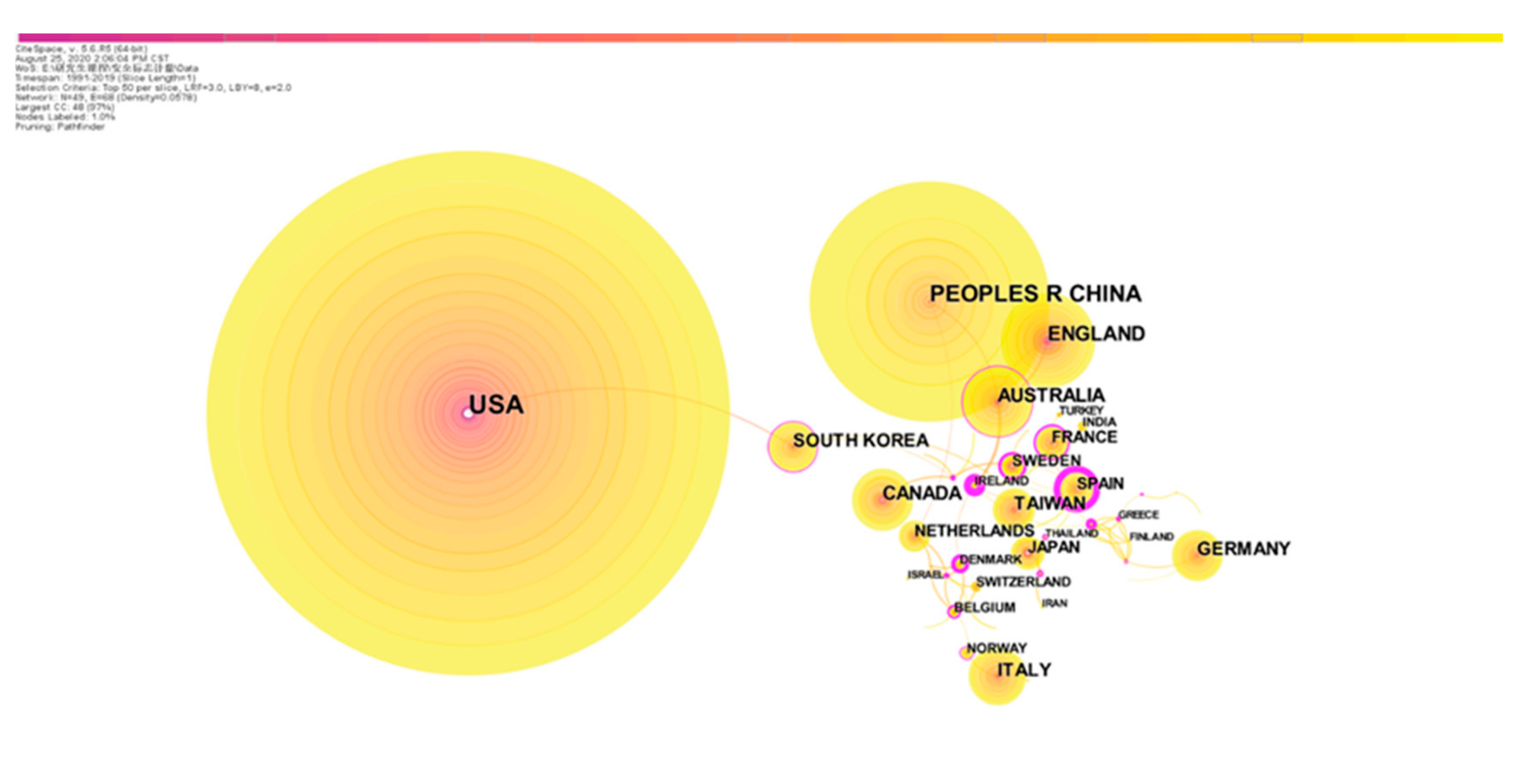
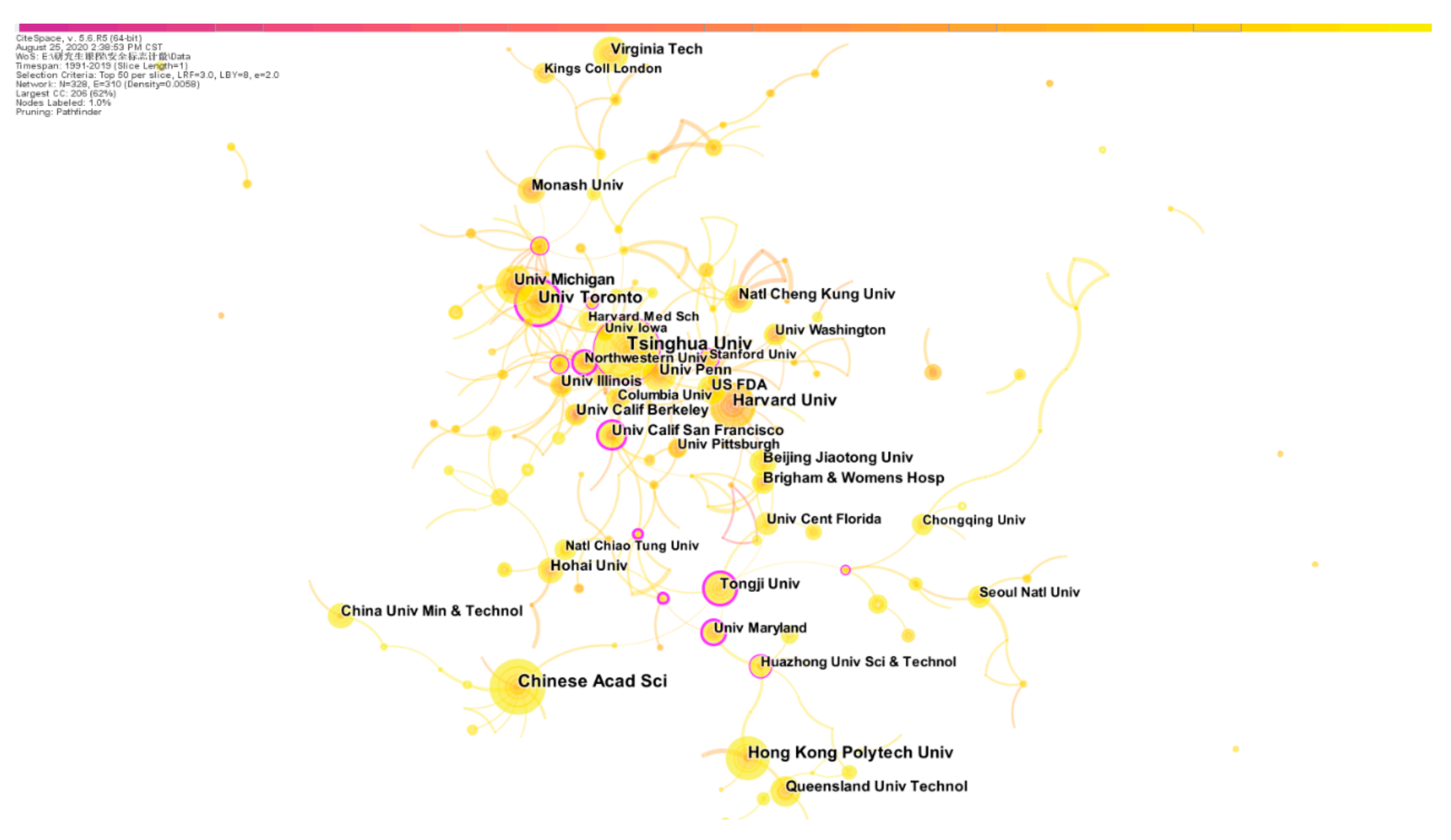
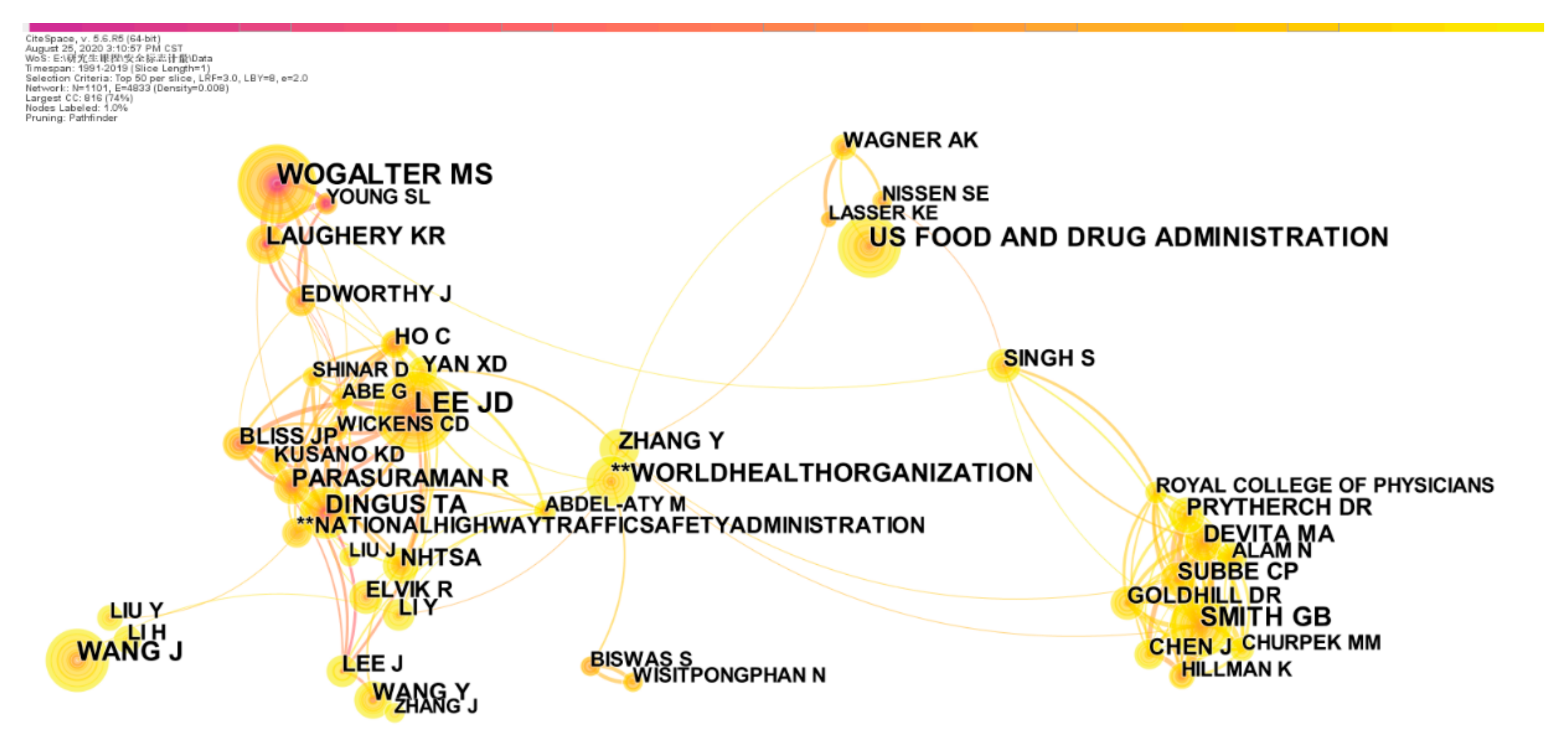
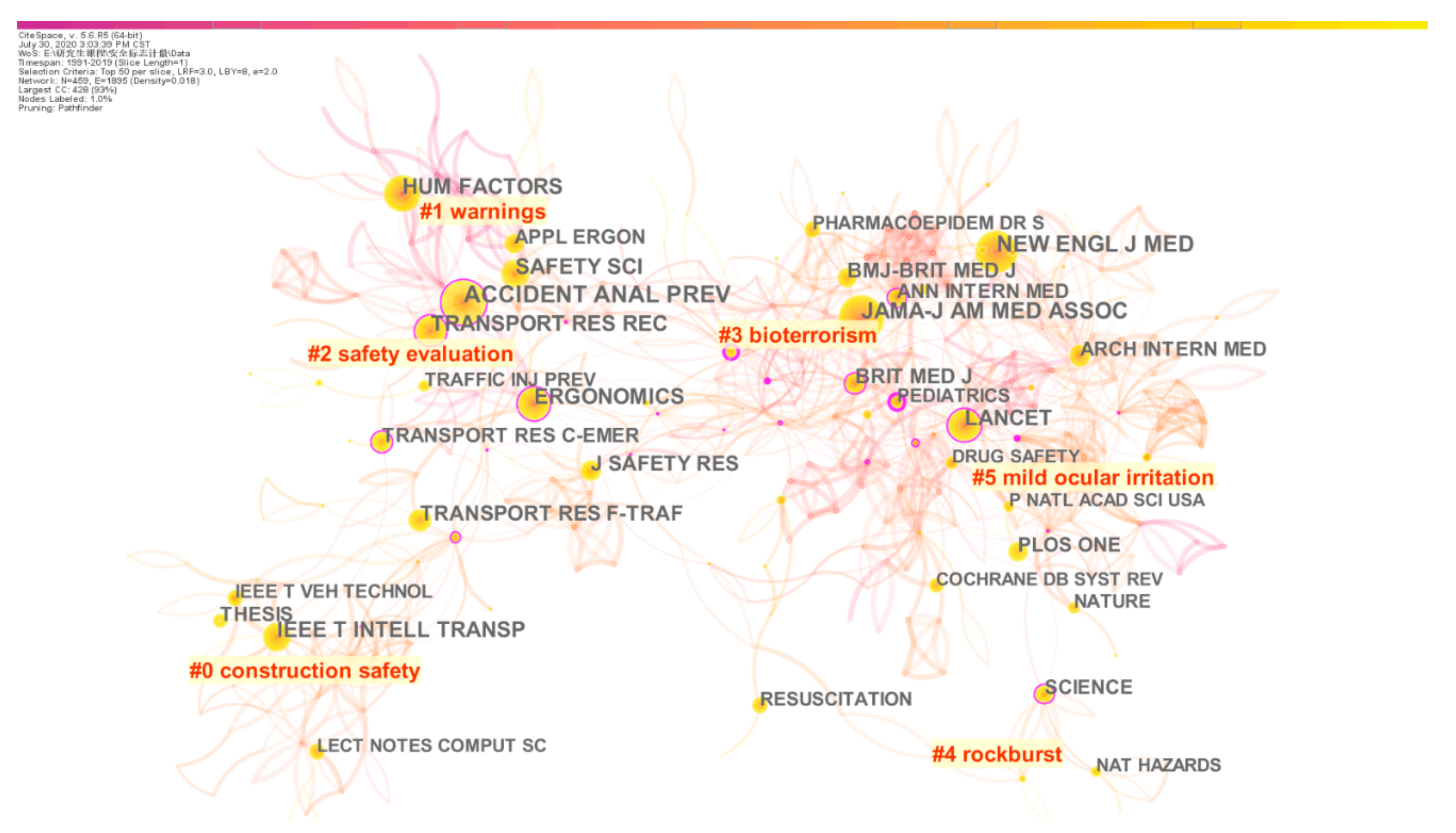
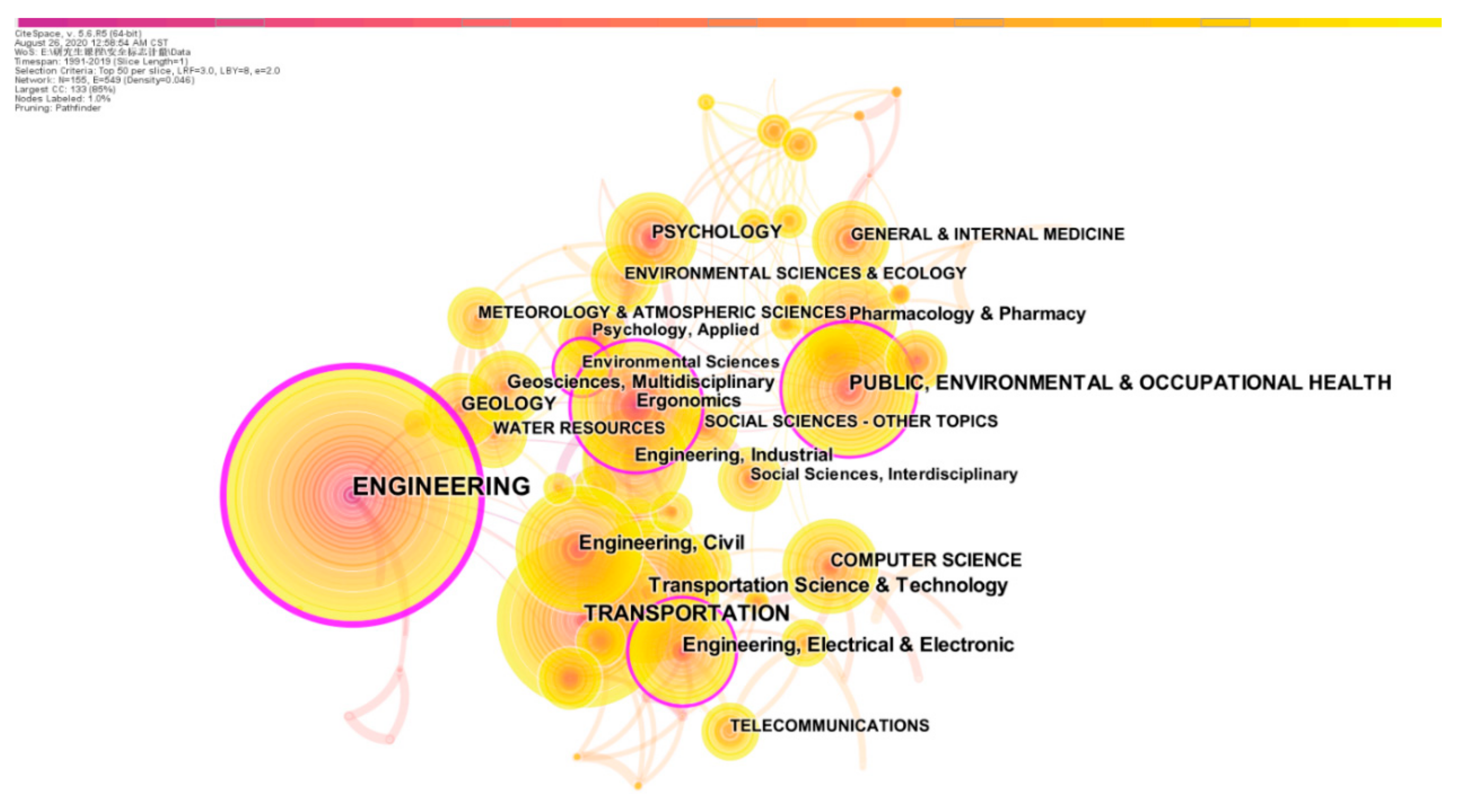
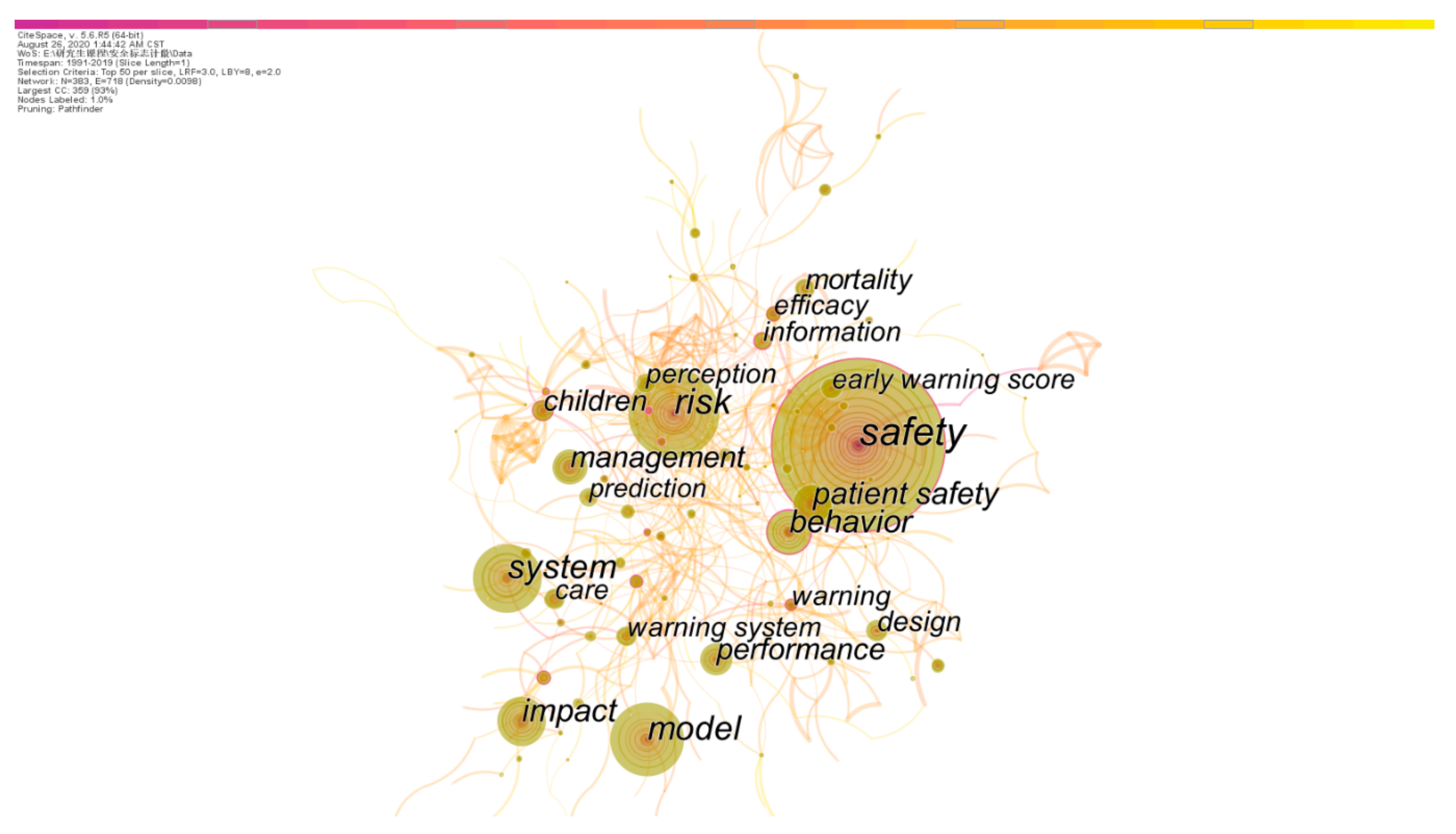

| Author Name | Number of Published Articles | Year 1 | Co-Authors (Frequency) | Main Research Interests |
|---|---|---|---|---|
| Hampton C. Gabler | 10 | 2014 | Kristofer D. Kusano (5) | Traffic safety |
| M.S. Wogalter | 9 | 1995 | Kalsher, M.J.; N.C. Silver Laugher, Kenneth R. (2) | Significance and comprehensibility of safety signs |
| Xiaoyuan Wang | 7 | 2018 | Yaqi Liu; Fang Wang; Yuanyuan Xia (4) | Traffic safety |
| Jane Sandall | 7 | 2012 | Nicola Mackintosh (6) | Patient safety |
| Yina Wu | 5 | 2018 | Mohamed Abdelaty (5) | Traffic safety |
| Heng Li | 5 | 2018 | Dong Chao; Ding Lieyun; Luo Hanbin; Luo Xiaochun; Wong Arnold Yu Lok (2) | Construction safety |
| Gary B. Smith | 5 | 2010 | Peter Griffiths (3) | Patient safety |
| Faisal Khan | 5 | 2014 | Paltrineri, Nicola; Cozzani, Valerio (2) | Industrial safety (emergency) |
| Yiqi Zhang | 4 | 2016 | Changxu Wu (4) | Traffic safety (warnings) |
| Man Ho Kim | 4 | 2010 | Lee, Suk; Lee, Kyung Chang (3) | Traffic safety (intelligent vehicles) |
| Julie Considine | 4 | 2016 | Judy Currey (4) | Patient safety |
| Juancarlos Cano | 4 | 2012 | Francisco J. Martinez; Carlos T. Calafate (4) | Warnings |
| Jianqiang Wang | 4 | 2015 | KeqiangLi (2) | Driving safety |
| Cluster ID | Size | Silhouette | Label (LLR) | Year Ave. |
|---|---|---|---|---|
| 0 | 125 | 0.838 | maternal early warning criteria | 2012 |
| 1 | 84 | 0.896 | advisory warning | 2009 |
| 2 | 52 | 1.000 | construction site | 2013 |
| 3 | 44 | 0.916 | various safety-critical situation | 2014 |
| 5 | 42 | 0.933 | fog condition | 2012 |
| 4 | 42 | 0.892 | vibration pattern | 2013 |
| 6 | 35 | 1.000 | pattern analysis | 2003 |
| 7 | 34 | 0.995 | safety warning | 2007 |
| 9 | 31 | 0.996 | water-sport prohibitive symbol | 2009 |
| Cluster #1 Advisory Warning | |||
|---|---|---|---|
| Cited References | Citing Articles | ||
| Cites | Author (Year) Journal, Volume, Page | Coverage % | Author (Year) Title |
| 14 | Biswas, S. (2006), IEEE COMMUN MAG, V44, P74 | 7 | Kakkasageri, M.S. (2014) Information management in vehicular Ad Hoc networks: a review. |
| 12 | Wisitpongphan, N. (2007), IEEE WIREL COMMUN, V14, P84 | 7 | Tak, Sehyun (2015) Development of a deceleration-based surrogate safety measure for rear-end collision risk. |
| 8 | Sengupta, R. (2007), J INTELL TRANSPORT S, V11, P143 | 6 | Rhiu, Ilsun (2015) Research issues in smart vehicles and elderly drivers: a literature review. |
| 7 | Hartestein, H. (2008), IEEE COMMUN MAG, V46, P164 | 5 | Song, Xiang (2015) Key parameters estimation and adaptive warning strategy for rear-end collision of vehicle. |
| 6 | Falk, B. (2009), TRANSPORT RES F-TRAF, V12, P1 | 5 | Maag, Christian (2015) Car gestures—advisory warning using additional steering wheel angles. |
| Cluster #3 Various Safety-Critical Situation | |||
|---|---|---|---|
| Cited References | Citing Articles | ||
| Cites | Author (Year) Journal, Volume, Page | Coverage % | Author (Year) Title |
| 15 | Jermakian, J.S. (2011), ACCIDENT ANAL PREV, V43, P732 | 20 | Winkler, Susann (2018) How to warn drivers in various safety-critical situations—different strategies, different reactions. |
| 12 | Cicchino, J.B. (2017), ACCIDENT ANAL PREV, V99, P142 | 17 | Winkler, Susann (2018) Practice makes better—learning effects of driving with a multi-stage collision warning. |
| 9 | Yan, X.D. (2015), TRANSPORT RES C-EMER, V51, P231 | 6 | Kaplan, Sigal (2012) Associating crash avoidance maneuvers with driver attributes and accident characteristics: a mixed logit model approach. |
| 9 | Fildes, B. (2015), ACCIDENT ANAL PREV, V81, P24 | 6 | Kaplan, Sigal (2012) The application of the random regret minimization model to drivers’ choice of crash avoidance maneuvers. |
| 7 | Reagan, I.J. (2016), TRAFFIC INJ PREV, V17, P827 | 6 | Cicchino, Jessica B (2018) Effects of lane departure warning on police-reported crash rates. |
| Cluster ID | Size | Label (LLR) | Year Ave. | The Most Active Cited Reference (Author Title) | Number of Burst Keywords |
|---|---|---|---|---|---|
| #0 | 53 | physician | 2006 | Davis, Terry C. (2009) Improving patient understanding of prescription drug label instructions. | 8 |
| #1 | 38 | injury | 2008 | Wogalter, M.S. (1999) The relative contributions of injury severity and likelihood information on hazard-risk judgments and warning compliance. | 9 |
| #2 | 36 | forward collision | 2005 | Cualain, D.O. (2012) Automotive standards-grade lane departure warning system. | 6 |
| #3 | 36 | consumer product safety | 2003 | BRAUN, C.C. (1995) Interaction of signal word and color on warning labels—differences in perceived hazard and behavioral compliance. | 8 |
| #4 | 35 | efficacy | 2006 | Cheng, Christine M. (2009) A review of three stand-alone topical thrombin for surgical hemostasis. | 0 |
Publisher’s Note: MDPI stays neutral with regard to jurisdictional claims in published maps and institutional affiliations. |
© 2021 by the authors. Licensee MDPI, Basel, Switzerland. This article is an open access article distributed under the terms and conditions of the Creative Commons Attribution (CC BY) license (http://creativecommons.org/licenses/by/4.0/).
Share and Cite
Gao, J.; Wu, X.; Luo, X.; Guan, S. Scientometric Analysis of Safety Sign Research: 1990–2019. Int. J. Environ. Res. Public Health 2021, 18, 273. https://doi.org/10.3390/ijerph18010273
Gao J, Wu X, Luo X, Guan S. Scientometric Analysis of Safety Sign Research: 1990–2019. International Journal of Environmental Research and Public Health. 2021; 18(1):273. https://doi.org/10.3390/ijerph18010273
Chicago/Turabian StyleGao, Jingqi, Xiang Wu, Xiaowei Luo, and Shukai Guan. 2021. "Scientometric Analysis of Safety Sign Research: 1990–2019" International Journal of Environmental Research and Public Health 18, no. 1: 273. https://doi.org/10.3390/ijerph18010273
APA StyleGao, J., Wu, X., Luo, X., & Guan, S. (2021). Scientometric Analysis of Safety Sign Research: 1990–2019. International Journal of Environmental Research and Public Health, 18(1), 273. https://doi.org/10.3390/ijerph18010273







